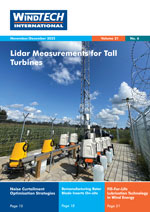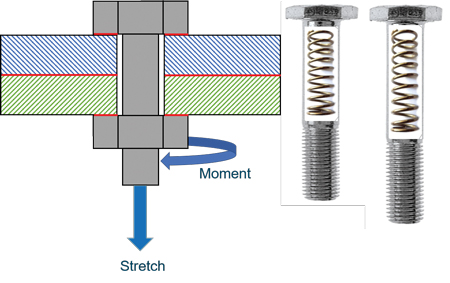 Correct Tension is Essential to Safety and Product Reliability
Correct Tension is Essential to Safety and Product ReliabilityAchieving and maintaining the right tension in bolted joints in wind turbines can help prevent system failures and associated repair costs. One loose bolt in a cluster of several hundred holding a structure together, often interdependently, can cause a domino effect that could, at worst, result in failure of the entire unit. As wind turbines continue to increase in size, the structures need to withstand ever higher centrifugal and bending forces, as well as vibrations – all factors that can affect the integrity of bolted joints. Correct bolt tensioning is, therefore, critical. But, accurate bolt tension is not only difficult to achieve, it can also be difficult to monitor. Danish engineering company R&D has developed an accurate system that uses both mechanical and ultrasonic measurements to determine the desired bolt tension in a way that also saves time. The solution can also digitally track individual bolts throughout their lifetime, ensuring the condition of the bolts is documented.
By Flemming Selmer Nielsen, Senior Specialist Engineer, R&D, Denmark
R&D discovered that the incorrect tension of bolts was often the root cause of broken bolts in wind turbines. A team of mechanical and materials engineers was tasked with developing a solution to the question of how to achieve and maintain correct bolt tension.
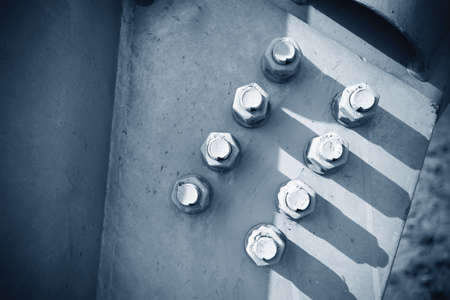 Achieving Correct Bolt Tension is a Challenge
Achieving Correct Bolt Tension is a ChallengeThe tension applied when tightening a bolt results in an opposing clamping force that holds the individual sections of the joint together. If too low, separation and bolt fatigue may occur, and if too high, excessive stretching may result in damage to structural components of the joint, causing breakage. Problems such as bolt fatigue and vibration loosening can often be prevented by achieving and maintaining the correct clamping force in the joint. The challenge is to measure this accurately.
Traditional Measurement of Tension
Traditionally, when tightening bolts the torque is measured and converted into a clamping force. But, due to numerous factors such as production tolerances, friction coefficients, lubrication and human error, the actual tension is very difficult to determine. Standards specify a ± 30% safety margin, but in reality, R&D specialists have measured up to 70% deviation from the defined tension. Even if bolts are tightened by tensioning, R&D has on several occasions experienced that the clamping force is insufficient. As such, they do not offer the consistent reliability that is required in the harsh environment of wind turbines.
Traditionally, when tightening bolts the torque is measured and converted into a clamping force. But, due to numerous factors such as production tolerances, friction coefficients, lubrication and human error, the actual tension is very difficult to determine. Standards specify a ± 30% safety margin, but in reality, R&D specialists have measured up to 70% deviation from the defined tension. Even if bolts are tightened by tensioning, R&D has on several occasions experienced that the clamping force is insufficient. As such, they do not offer the consistent reliability that is required in the harsh environment of wind turbines.
Bolts Increase in Length Like a Spring
The R&D engineering team set out to investigate whether there was another way to measure wind turbine bolt tension accurately, not only to support safety but also to attempt to reduce some of the heavy and labour-intensive steps involved in measuring bolt tension. A bolt subject to pre-tension increases in length; it behaves like a spring. As the bolt extends in response to the torque applied, the resulting elongation can be measured using ultrasound signals created by sensors similar to those a car employs to measure the size of a parking space.
The R&D engineering team set out to investigate whether there was another way to measure wind turbine bolt tension accurately, not only to support safety but also to attempt to reduce some of the heavy and labour-intensive steps involved in measuring bolt tension. A bolt subject to pre-tension increases in length; it behaves like a spring. As the bolt extends in response to the torque applied, the resulting elongation can be measured using ultrasound signals created by sensors similar to those a car employs to measure the size of a parking space.
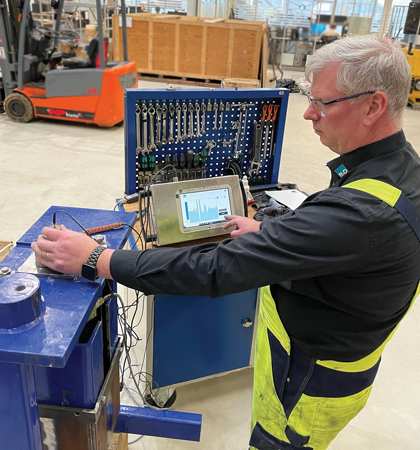 Ultrasonic Properties Change When Under Tension
Ultrasonic Properties Change When Under TensionThe ultrasonic properties of the material change when under tension. This affects the ultrasonic measurements. If the bolt can be measured in both the loaded and unloaded conditions, these property changes are handled automatically by the ultrasonic device. The challenge was that R&D was often asked to evaluate existing bolted connections in which the bolts were all tightened. To determine the accurate clamping force, the bolts had to be loosened as part of the process. This was time-consuming and, in some cases, specifications required exchange of bolts if they were loosened. Therefore, R&D started looking for a solution that would allow measurement of the actual clamping force in tensioned bolts without loosening them.
Bolt Tension Measurement System
R&D’s bolt tension measurement system was successfully launched in 2019. The idea was straightforward: without loosening all the bolts, it was possible to calculate the tension already applied to a bolt in situ. The method is based on combining an ultrasonic length measurement with a mechanical measurement using a customised tool featuring a micro gauge and ultrasonic measurement.
R&D’s bolt tension measurement system was successfully launched in 2019. The idea was straightforward: without loosening all the bolts, it was possible to calculate the tension already applied to a bolt in situ. The method is based on combining an ultrasonic length measurement with a mechanical measurement using a customised tool featuring a micro gauge and ultrasonic measurement.
After calibrating the system by measuring a few identical but unloaded bolts, it is possible to measure and thereby determine the actual clamping force on the already tensioned bolts within 10% accuracy.
Calibration Required for Accurate Results
Central to the accuracy of the Bolt-Check system is sorting the bolts into batches that possess the same material properties. Bolts can be made from many different materials including iron, various grades of steel, carbon steel, and steel alloys to name the most common examples.
Central to the accuracy of the Bolt-Check system is sorting the bolts into batches that possess the same material properties. Bolts can be made from many different materials including iron, various grades of steel, carbon steel, and steel alloys to name the most common examples.
The bolt materials influence the speed of sound used in the ultrasonic measurement because they have differing elasticity, a factor that affects the travel of the ultrasonic measurement signal. So, accurately categorising bolts made from different materials into batches makes it possible to obtain a reliable calculation of the bolt tension without having to loosen them.
 Every Bolt Uniquely Tagged and Traced
Every Bolt Uniquely Tagged and TracedThe Bolt-Check system can both be used when installing new bolts and when evaluating existing bolts as part of the installation and service procedures of wind turbines. To secure traceability and a detailed documentation trail, a unique ID tag is added to each bolt. This supports pre-failure diagnosis and the data collected and stored securely online includes the location of each bolt as well as its service and maintenance schedule. The Bolt-Check system can be used directly on standard bolts with no additional machining or logistics required.
The Bolt-Check system consists of a handheld ultrasonic probe, a temperature sensor, a radio-frequency identification reader, a portable measuring unit with a touchscreen, and ID tags for each bolt.
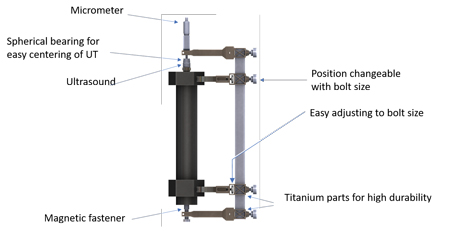 During the tightening procedure, the change in length is measured and stored. This can be done either by measuring the length before and after the tensioning procedure or by measuring during the tension process.
During the tightening procedure, the change in length is measured and stored. This can be done either by measuring the length before and after the tensioning procedure or by measuring during the tension process.Call-Out Charges and Repair Costs Among Benefits
The benefits to the wind turbine industry are wide-ranging and include reduced installation time as well as possible lower call-out charges and downtime costs, which can be significant, particularly in the offshore sector. Reduced risk of overall wind turbine failure ultimately offers peace of mind to wind turbine manufacturers and park owners. Furthermore, the Bolt-Check system offers significantly lower costs and improved HSE compared with traditional torque and tension methods. Additionally, the costs for maintaining the torque and tension tools can be close to eliminated.
The benefits to the wind turbine industry are wide-ranging and include reduced installation time as well as possible lower call-out charges and downtime costs, which can be significant, particularly in the offshore sector. Reduced risk of overall wind turbine failure ultimately offers peace of mind to wind turbine manufacturers and park owners. Furthermore, the Bolt-Check system offers significantly lower costs and improved HSE compared with traditional torque and tension methods. Additionally, the costs for maintaining the torque and tension tools can be close to eliminated.
Patent Granted
In September 2020, R&D was granted a patent for its Bolt Tension Measuring Device and Method innovation. Although the use of ultrasound for measuring distance is not new, Bolt-Check can be used to determine the actual clamping force in existing bolted joints without loosening the bolts – something which is not possible with other systems. This not only saves a step in the process but also makes it quicker to use.
In September 2020, R&D was granted a patent for its Bolt Tension Measuring Device and Method innovation. Although the use of ultrasound for measuring distance is not new, Bolt-Check can be used to determine the actual clamping force in existing bolted joints without loosening the bolts – something which is not possible with other systems. This not only saves a step in the process but also makes it quicker to use.
DNV GL Product Certificate
At the end of 2020, the Bolt-Check system received a full type product certificate from DNV GL. Bolt-Check is produced in Denmark and is supplied to wind turbine customers around the world.
At the end of 2020, the Bolt-Check system received a full type product certificate from DNV GL. Bolt-Check is produced in Denmark and is supplied to wind turbine customers around the world.
Biography of the Author
Flemming Selmer Nielsen is Senior Specialist Engineer at R&D. Prior to joining the company in 2014, he worked as Senior Engineer for a large wind turbine manufacturer. At R&D, he provides customer engineering advice and supplies measurement know-how for applications including wind turbines, bridges and sea fastenings. During the past 25 years, Flemming Selmer Nielsen, who graduated from Aarhus University with a degree in mechanical engineering, has accumulated a wealth of knowledge about bolts.
Flemming Selmer Nielsen is Senior Specialist Engineer at R&D. Prior to joining the company in 2014, he worked as Senior Engineer for a large wind turbine manufacturer. At R&D, he provides customer engineering advice and supplies measurement know-how for applications including wind turbines, bridges and sea fastenings. During the past 25 years, Flemming Selmer Nielsen, who graduated from Aarhus University with a degree in mechanical engineering, has accumulated a wealth of knowledge about bolts.



